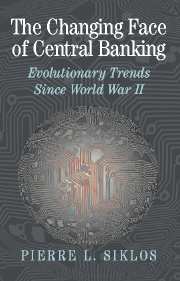Book contents
- Frontmatter
- Contents
- List of Figures
- List of Tables
- Preface
- 1 The Institutional Make-Up and Evolution of Central Bank–Government Relations: An Introduction
- 2 Legislation Alone Does Not a Central Bank Make: Political Structure, Governance, and Reputation in Monetary Policy
- 3 Central Bank Personalities and Monetary Policy Performance
- 4 Econometric Analysis of Central Bank Behavior: An Evolutionary Approach
- 5 Contrasting Quantitative and Qualitative Assessments of Central Bank Behavior and the Evolution of Monetary Policies
- 6 Accountability, Disclosure, and Conflict Resolution
- 7 Inflation Targets versus Other Inflation Control Measures: Two Sides of the Same Coin?
- 8 The Changing Face of Central Banking: Epilogue
- Bibliography
- Index
- Titles in the series
2 - Legislation Alone Does Not a Central Bank Make: Political Structure, Governance, and Reputation in Monetary Policy
Published online by Cambridge University Press: 27 October 2009
- Frontmatter
- Contents
- List of Figures
- List of Tables
- Preface
- 1 The Institutional Make-Up and Evolution of Central Bank–Government Relations: An Introduction
- 2 Legislation Alone Does Not a Central Bank Make: Political Structure, Governance, and Reputation in Monetary Policy
- 3 Central Bank Personalities and Monetary Policy Performance
- 4 Econometric Analysis of Central Bank Behavior: An Evolutionary Approach
- 5 Contrasting Quantitative and Qualitative Assessments of Central Bank Behavior and the Evolution of Monetary Policies
- 6 Accountability, Disclosure, and Conflict Resolution
- 7 Inflation Targets versus Other Inflation Control Measures: Two Sides of the Same Coin?
- 8 The Changing Face of Central Banking: Epilogue
- Bibliography
- Index
- Titles in the series
Summary
INTRODUCTION
One of the aims of this book is to blend purely economic analyses of central bank behavior since the end of World War II with what has been learned in related literatures in the political economy and public choice areas. In so doing some familiar ground is covered. However, the various strands of the literature referred to above have taken divergent paths, particularly over the last decade. While this outcome is perhaps understandable, given the complexity of the issues under discussion, it is also one that is profoundly unsatisfactory. In discussions about central bank independence in recent years many observers have lost sight of the fact that monetary policy is ultimately a joint responsibility of the government and the central bank, no matter how much autonomy is permitted by statute. As a result, there may be a connection between a particular political structure, autonomy, and the performance of a central bank.
More surprisingly, there has been relatively less discussion about the process by which decisions are made by central banks. Instead, economics has been preoccupied with the relative importance of inflation versus other potential objectives the monetary authority may pursue and their connection with interest rate developments especially. Consequently, governance issues have yet to make their mark in our understanding of central bank behavior, a significant lacuna already noted in Chapter 1.
An important feature of later chapters of this book is the resort to macroeconomic and institutional data from a cross section of countries.
- Type
- Chapter
- Information
- The Changing Face of Central BankingEvolutionary Trends since World War II, pp. 26 - 80Publisher: Cambridge University PressPrint publication year: 2002



